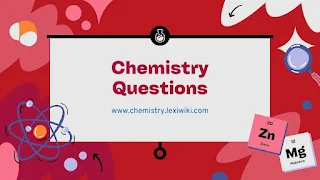Questions on Atomic Emission Spectra
20 Multiple-Choice Questions: Atomic Emission Spectra
1. What is an atomic emission spectrum?
A) The range of all wavelengths emitted by any object
B) A continuous band of colors from white light
C) A series of bright lines produced when electrons fall to lower energy levels
D) A black-and-white shadow pattern
E) The color of an atom under a microscope
2. Which subatomic particle is primarily responsible for atomic emission spectra?
A) Proton
B) Neutron
C) Photon
D) Electron
E) Nucleon
3. What causes the bright lines in an emission spectrum?
A) Nuclei decay
B) Electrons gaining energy
C) Electrons absorbing energy
D) Electrons jumping to higher orbits
E) Electrons falling to lower energy levels and emitting photons
4. The atomic emission spectrum of each element is:
A) Identical
B) Continuous
C) Unique
D) Invisible
E) White
5. Which instrument is commonly used to observe atomic emission spectra?
A) Calorimeter
B) Spectroscope
C) Thermometer
D) Electron microscope
E) Barometer
6. The lines in the hydrogen spectrum correspond to:
A) Protons shifting orbits
B) Neutron emissions
C) Electron transitions between energy levels
D) Molecular vibrations
E) Nuclear fusion
7. What kind of spectrum does a heated element emit?
A) Continuous spectrum
B) Absorption spectrum
C) Infrared radiation
D) Line (emission) spectrum
E) X-ray spectrum
8. What happens to energy when an excited electron returns to a lower energy level?
A) It is absorbed
B) It is converted to mass
C) It is emitted as a photon
D) It disappears
E) It strengthens chemical bonds
9. Which of the following best describes a photon?
A) A negatively charged particle
B) A bundle of electromagnetic energy
C) A type of atom
D) A radioactive particle
E) A molecule
10. Why do different elements emit different line spectra?
A) They have different sizes
B) They have different temperatures
C) They have different electron configurations
D) They have different masses
E) They vibrate at different speeds
11. The colors seen in fireworks are due to:
A) Temperature variations
B) Chemical combustion only
C) Emission spectra of different elements
D) The air pressure
E) Refraction through smoke
12. The Balmer series in hydrogen emission involves electron transitions to which energy level?
A) n = 1
B) n = 2
C) n = 3
D) n = 4
E) n = 5
13. What is the energy of a photon related to?
A) Its amplitude
B) Its speed
C) Its frequency
D) Its polarization
E) Its color only
14. Which series in the hydrogen spectrum lies in the ultraviolet region?
A) Lyman
B) Balmer
C) Paschen
D) Brackett
E) Pfund
15. Why is the atomic emission spectrum not continuous?
A) Electrons don’t move
B) Only specific energy levels exist
C) Light is refracted
D) Photons are not emitted
E) Energy is absorbed, not released
16. The atomic emission spectrum is evidence for:
A) The uncertainty principle
B) The wave model of matter
C) Quantized energy levels in atoms
D) The speed of light
E) Chemical bonding
17. Which color in the visible spectrum has the most energy?
A) Red
B) Orange
C) Yellow
D) Green
E) Violet
18. What do we call the process when an atom emits a photon?
A) Absorption
B) Excitation
C) Ionization
D) Relaxation
E) Fusion
19. What determines the color of light emitted in atomic spectra?
A) Atomic size
B) Type of nucleus
C) Wavelength of the photon emitted
D) Number of neutrons
E) Number of protons
20. Which application relies on atomic emission spectra?
A) MRI scanners
B) Spectroscopy in chemical analysis
C) Nuclear power generation
D) Blood pressure measurement
E) Battery storage
- Questions on Wavelength and Frequency Calculations
- Questions on Quantization of Energy
- Questions on Photoelectric Effect
Answers with Extended Explanations
1. C – Emission spectra consist of bright lines corresponding to photons emitted when electrons fall to lower energy levels.
2. D – Electrons absorb and emit energy, leading to spectral lines.
3. E – When electrons return to lower orbits, they release energy as photons.
4. C – Each element has a unique set of energy levels, producing a unique spectrum.
5. B – A spectroscope separates light into its component wavelengths.
6. C – The hydrogen spectrum results from electron transitions.
7. D – Heated elements emit discrete spectral lines characteristic of their atoms.
8. C – The energy lost by electrons is emitted as photons of light.
9. B – A photon is a quantum of light or electromagnetic energy.
10. C – Different electron arrangements produce different transitions and spectra.
11. C – Fireworks use metal salts that emit characteristic colors.
12. B – The Balmer series includes transitions ending at n = 2, visible region.
13. C – Photon energy is directly proportional to frequency: E=hfE = hfE=hf.
14. A – The Lyman series involves transitions to n = 1, in the UV region.
15. B – Atoms have specific allowed energy levels, not continuous ones.
16. C – Emission spectra support the concept of quantized electron energy levels.
17. E – Violet light has the highest frequency and energy in the visible spectrum.
18. D – Relaxation is when an electron emits a photon and drops to a lower energy state.
19. C – Photon color (and energy) depends on wavelength, which is inversely related to frequency.
20. B – Spectroscopy uses emission spectra to identify elements in a substance.
Dive into the groundbreaking science of neurotransmitters—your brain’s invisible architects—in Chemical Harmony: How Neurotransmitters Shape Our Lives (2025). This meticulously researched book reveals how serotonin, dopamine, GABA, and other brain chemicals silently orchestrate every aspect of your existence, from decision-making and relationships to mental health and emotional resilience.Click here to buy
Share Online!

